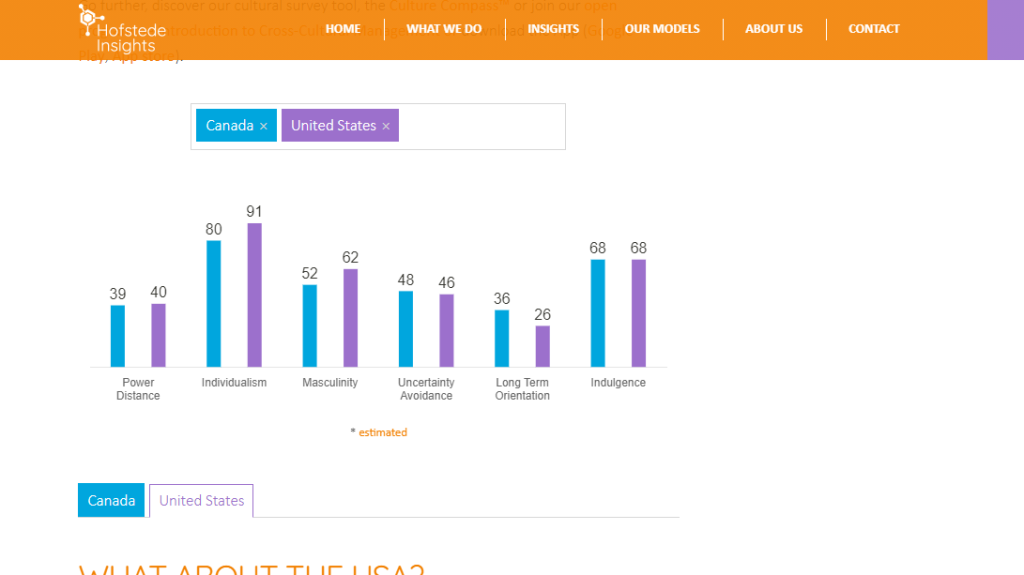Introduction
Different countries have different cultures that make businesses operate differently to make a profit. The cultural differences call for business people to embrace and appreciate the differences and use them to their advantage. For instance, in some cultures, people are more punctual, while in others, people are less punctual. Thus, a business can be less punctual in a business negotiation in a culturally less punctual society while remaining punctual in talks in a more punctual community, eventually resulting in excellent time utility and business success. There are different cultures in various countries, and therefore, business is conducted differently between other countries. For instance, Canada and the United States have different cultures, such as individualism and masculinity, and therefore business is done differently concerning those cultural differences. However, some cultural aspects are similar to other counties, making the company’s conduct identical in other counties. For instance, in the United States and Canada, the indulgence dimension is exact, making people have a similar tendency in their livelihoods.
Selected Country
In comparing Hofstede’s Six Cultural Dimensions with the United States, I selected Canada because it gives scholars a decent impression of the Canadian culture compared to other cultures, such as the American culture. Noticeably, the Canadian culture compares perfectly with the United States culture as the two countries have as many differences as similarities, as evident in the graph by Hofstede’s Six Dimensions website.
Analysis of Hofstede’s Six Cultural Dimensions
The six cultural dimensions provided in Hofstede’s Six Cultural Dimensions website include power distance, individualism, masculinity, uncertainty avoidance, long-term orientation, and indulgence. Among the dimensions, the two countries share some similarities and also have their differences in various dimensions. Notably, the United States and Canada share the dimensions of power distance, indulgence, and uncertainty avoidance. The power distance dimension entails a culture’s attitude towards power inequalities amongst individuals in society. The two countries have almost a similar score on the dimension, showing that people do not identify themselves in distinct classes or social groups. Consequently, people are equal, and in the places of work, supervisors are easily accessible by staff members consultation and sharing of information are free.
Besides, the two countries have closely differing indulgence scores, which means that people in the two countries have a similar tendency when controlling their desires and impulses depending on how they grew. In the two countries, people tend to have fun while still pushing to meet their dreams in life. Moreover, the two countries share a score on the uncertainty avoidance dimension, as depicted in Hofstede’s Six Cultural Dimensions website. Uncertainty avoidance encompasses the way society handles the reality that the future is unknown to people. Consequently, Hofstede’s Six Cultural Dimensions website shows that the uncertainty avoidance in the United States and Canada are 46 and 48, respectively. The countries’ scores are slightly below average; therefore, people from the two cultures tend to accept uncertainty more than others that score higher on that dimension.
However, despite various cultural similarities, the United States and Canada also have differences in different cultural dimensions, as depicted in the website of Hofstede’s Six Cultural Dimensions. The cultural dimensions include individualism, masculinity, and long-term orientation. Individualism entails the extent of interdependence between members of society and is different in the United States and Canada. For instance, in Canada, people are more self-reliant; thus, in the business world, staffs are more individualistic. On the other hand, in the United States, people are more social and collective and tend to live and accord liberty to people in larger groups.
Furthermore, the masculinity dimension examines the motivation behind people’s success between being the best and liking what one does. In the United States, the masculinity score is high (62), indicating that people are motivated and achieve more because they want to be the best. In Canada, the cultural score depicts people performing more because they like what they do. Lastly, long-term orientation examines how a country preserves its relation to the past while handling current and future challenges. The United States scores low, meaning the people are more linked to the past than Canadians.
Implications of the differences in the Dimensions.
The cultural differences between the United States and Canada imply that businesses are different in the two countries. For instance, the company should set up a work environment that motivates Canadian people to achieve more because they like the job. In the United States, the focus should be on encouraging people to become the best among other staff members. Besides, while ensuring staff members are equal, businesses should motivate people to achieve more at work or for fun. Moreover, companies should provide to set up similar business setups because people from both cultures accept the uncertain future and are more practical.
How Hofstede’s Dimensions Help in the Venture and Conclusion.
The gathered information will make me negotiate decisively and persuasively to achieve the best while still at peace with my Canadian counterparts because I am aware of and appreciate our cultural differences. Moreover, I will be sure to enquire about a few clarifications where necessary. In conclusion, Hofstede’s Six Cultural Dimensions website has clearly and precisely highlighted the difference in cultural dimensions between the United States, making it possible to make informed decisions when expounding business to Canada.
The following figure illustrates the comparison graph between the United States and Canada as it is on Hofstede’s Six Cultural Dimensions website.

References
Caputo, A., Ayoko, O. B., Amoo, N., & Menke, C. (2019). The relationship between cultural values, cultural intelligence and negotiation styles. Journal of Business Research, 99, 23-36. Retrieved from https://www.sciencedirect.com/science/article/pii/S0148296319301018
 write
write